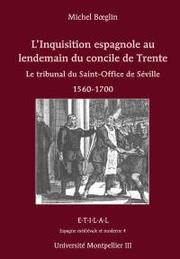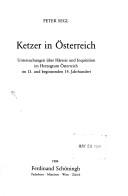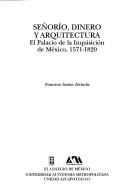| Listing 1 - 10 of 13 | << page >> |
Sort by
|
Book
ISBN: 3968690214 9783968690216 9783968690209 9783968690216 Year: 2020 Publisher: Madrid : Iberoamericana Editorial Vervuert,
Abstract | Keywords | Export | Availability | Bookmark
 Loading...
Loading...Choose an application
- Reference Manager
- EndNote
- RefWorks (Direct export to RefWorks)
Este libro vuelve a la temática inquisitorial con un planteamiento nuevo y a través de fuentes documentales novedosas, desconocidas en muchos casos, para ofrecernos una visión del fenómeno inquisitorial ciertamente inédita.La Inquisición vista desde abajo coloca en el centro del análisis a gente corriente que se vio involucrada en los tribunales. Con ellos, aparecen los ministros de la Inquisición, actuando al pie de calle, ante quienes se presentaron un sinfín de deposiciones, acusaciones o testificaciones sobre asuntos de muy diversa índole. Tras el estudio de una selección de ellas, aparece ante nuestros ojos toda una panoplia de creencias, miedos y prejuicios anidados en las mentalidades y en la cultura popular de aquella época, lo cual nos ayuda a entender el mundo del que procedemos y que nos conforma. Ha sido con este singular enfoque, como los cuatro autores de este libro han realizado su trabajo de investigación, indagando en los ricos fondos documentales que integran los expedientes de testificaciones existentes en los archivos inquisitoriales.
Book
ISBN: 3954879468 8491920188 Year: 2019 Publisher: Frankfurt am Main : Vervuert Verlagsgesellschaft,
Abstract | Keywords | Export | Availability | Bookmark
 Loading...
Loading...Choose an application
- Reference Manager
- EndNote
- RefWorks (Direct export to RefWorks)
APARECE EN DICIEMBRE DE 2018. Este libro ofrece estudios multidisciplinarios sobre la situación de la mujer en la Inquisición novohispana. A lo largo de trece capítulos se muestran diversos retratos de mujeres que, bajo acusaciones tan diversas como brujería, bigamia, falsa beatitud, herejía, etc., se presentaron ante los tribunales para responder de su vida. Proponemos así un estudio de su estatus social, sus motivaciones, las características de su procesamiento y las razones que justificaron la violencia ejercida sobre ellas.
Inquisition --- Witches --- Witchcraft --- Inquisición --- Brujas --- Brujería --- Black art (Witchcraft) --- Sorcery --- Occultism --- Wicca --- Occultists --- Warlocks --- Wiccans --- Holy Office --- Autos-da-fé --- History. --- Historia.
Book
ISBN: 3954875977 8484899136 Year: 2016 Publisher: Madrid ; Frankfurt am Main : Iberoamericana : Vervuert,
Abstract | Keywords | Export | Availability | Bookmark
 Loading...
Loading...Choose an application
- Reference Manager
- EndNote
- RefWorks (Direct export to RefWorks)
Edición crítica de la relación del "Auto de la fe, celebrado en Lima a 23 de enero de 1639", que redactó el licenciado Fernando de Montesinos. Incluye una serie de artículos que firman especialistas en la cuestión y que explican aspectos del proceso inquisitorial y de la situación del criptojudaísmo en el Nuevo Mundo.
Autos-da-fé --- Inquisition --- Trials (Heresy) --- Crypto-Jews --- Christianity and culture --- Auto de fe --- Inquisición --- Juicios (Herejía) --- Cripto Judíos --- Cristianismo y cultura --- Anusim --- Converts --- Jews --- Holy Office --- Heresy --- Auto-da-fés --- Auto-de-fés --- Autos-de-fe --- Sentences (Criminal procedure) --- History. --- History --- Historia. --- Historia --- Montesinos, Fernando, --- Tribunal de la Inquisición de Lima --- Catholic Church --- Iglesia Católica --- Tribunal del Santo Oficio de Lima --- Inquisición de Lima --- Church of Rome --- Roman Catholic Church --- Katholische Kirche --- Katolyt︠s︡ʹka t︠s︡erkva --- Römisch-Katholische Kirche --- Römische Kirche --- Ecclesia Catholica --- Eglise catholique --- Eglise catholique-romaine --- Katolicheskai︠a︡ t︠s︡erkovʹ --- Chiesa cattolica --- Kościół Katolicki --- Katolicki Kościół --- Kościół Rzymskokatolicki --- Nihon Katorikku Kyōkai --- Katholikē Ekklēsia --- Gereja Katolik --- Kenesiyah ha-Ḳatolit --- Kanisa Katoliki --- כנסיה הקתולית --- כנסייה הקתולית --- 가톨릭교 --- 천주교
Book
ISBN: 0812207645 0812244737 1322511969 Year: 2013 Publisher: Philadelphia : University of Pennsylvania Press,
Abstract | Keywords | Export | Availability | Bookmark
 Loading...
Loading...Choose an application
- Reference Manager
- EndNote
- RefWorks (Direct export to RefWorks)
While the Spanish Inquisition has laid the greatest claim to both scholarly attention and the popular imagination, the Roman Inquisition, established in 1542 and a key instrument of papal authority, was more powerful, important, and long-lived. Founded by Paul III and originally aimed to eradicate Protestant heresy, it followed medieval antecedents but went beyond them by becoming a highly articulated centralized organ directly dependent on the pope. By the late sixteenth century the Roman Inquisition had developed its own distinctive procedures, legal process, and personnel, the congregation of cardinals and a professional staff. Its legal process grew out of the technique of inquisitio formulated by Innocent III in the early thirteenth century, it became the most precocious papal bureaucracy on the road to the first "absolutist" state.As Thomas F. Mayer demonstrates, the Inquisition underwent constant modification as it expanded. The new institution modeled its case management and other procedures on those of another medieval ancestor, the Roman supreme court, the Rota. With unparalleled attention to archival sources and detail, Mayer portrays a highly articulated corporate bureaucracy with the pope at its head. He profiles the Cardinal Inquisitors, including those who would play a major role in Galileo's trials, and details their social and geographical origins, their education, economic status, earlier careers in the Church, and networks of patronage. At the point this study ends, circa 1640, Pope Urban VIII had made the Roman Inquisition his personal instrument and dominated it to a degree none of his predecessors had approached.
Criminal procedure (Canon law) --- Inquisition --- Holy Office --- Autos-da-fé --- Procedure (Canon law) --- History --- Catholic Church. --- Congregatio Romanae et Universalis Inquisitionis --- Suprema Congregatio Sanctae Romanae et Universalis Inquisitionis --- Sacred Congregation of the Universal Inquisition --- Congregation of the Universal Inquisition --- Sacrée Congrégation de l'inquisition romaine et universelle --- Congrégation de l'inquisition romaine et universelle --- Sacra Congregazione della romana e universale inquisizione --- Congregazione della romana e universale inquisizione --- Sagrada Congregación de la Universal Inquisición --- Congregación de la Universal Inquisición --- Italy --- Church history --- European History. --- History. --- Medieval and Renaissance Studies. --- Religion. --- Religious Studies. --- World History.

ISBN: 2842696050 9782842696054 Year: 2003 Volume: 4 Publisher: Montpellier Université Paul Valéry
Abstract | Keywords | Export | Availability | Bookmark
 Loading...
Loading...Choose an application
- Reference Manager
- EndNote
- RefWorks (Direct export to RefWorks)
Inquisition --- History. --- Histoire --- Tribunal de la Inquisición de Sevilla. --- Spain --- Espagne --- Church history --- Histoire religieuse --- 262.136.12 <460> --- Congregatie van het Heilig Officie (en voor de inquisitie)--Spanje --- 262.136.12 <460> Congregatie van het Heilig Officie (en voor de inquisitie)--Spanje --- Tribunal de la Inquisición de Sevilla. --- Spanish inquisition --- 16th-17th centuries --- Inquisition - Spain - Seville - History.

ISBN: 3506732552 9783506732552 Year: 1984 Volume: 5 Publisher: Paderborn Schöningh
Abstract | Keywords | Export | Availability | Bookmark
 Loading...
Loading...Choose an application
- Reference Manager
- EndNote
- RefWorks (Direct export to RefWorks)
Christian heretics --- History --- Inquisition --- Austria --- Church history --- 273 "12/13" --- 273 <436> --- Heretics, Christian --- -Heresies,Christian --- -Heresies and heretics --- Heretics --- Schisma's. Ketterijen--?"12/13" --- Schisma's. Ketterijen--Oostenrijk --- -Inquisition --- -Catholic Church. --- Inquisição --- Inquisición --- Inquisizione --- Church history. --- -Schisma's. Ketterijen--?"12/13" --- -Austria --- Heresies and heretics --- Catholic Church. --- Christian heretics - Austria - History --- Austria - Church history
Book
ISBN: 9780812245738 0812245733 1322513244 0812209346 Year: 2014 Publisher: Philadelphia University of Pennsylvania Press
Abstract | Keywords | Export | Availability | Bookmark
 Loading...
Loading...Choose an application
- Reference Manager
- EndNote
- RefWorks (Direct export to RefWorks)
From the moment of its founding in 1542, the Roman Inquisition acted as a political machine. Although inquisitors in earlier centuries had operated somewhat independently of papal authority, the gradual bureaucratization of the Roman Inquisition permitted the popes increasing license to establish and exercise direct control over local tribunals, though with varying degrees of success. In particular, Pope Urban VIII's aggressive drive to establish papal control through the agency of the Inquisition played out differently among the Italian states, whose local inquisitions varied in number and secular power. Rome's efforts to bring the Venetians to heel largely failed in spite of the interdict of 1606, and Venice maintained lay control of most religious matters. Although Florence and Naples resisted papal intrusions into their jurisdictions, on the other hand, they were eventually brought to answer directly to Rome—due in no small part to Urban VIII's subversions of the law. Thomas F. Mayer provides a richly detailed account of the ways the Roman Inquisition operated to serve the papacy's long-standing political aims in Naples, Venice, and Florence. Drawing on the Inquisition's own records, diplomatic correspondence, local documents, newsletters, and other sources, Mayer sheds new light on papal interdicts and high-profile court cases that signaled significant shifts in inquisitorial authority for each Italian state. Alongside his earlier volume, The Roman Inquisition: A Papal Bureaucracy and Its Laws in the Age of Galileo, this masterful study extends and develops our understanding of the Inquisition as a political and legal institution.
History of the law --- History of Italy --- Christian church history --- anno 1600-1699 --- anno 1500-1599 --- Inquisition --- Trials (Heresy) --- Inquisition. --- Trials (Heresy). --- History --- Catholic Church. --- 1500-1699. --- Italy --- Italy. --- Italien. --- Church history --- 262.136.12 <45 ROMA> --- Congregatie van het Heilig Officie (en voor de inquisitie)--Italië--ROMA --- Congregatio Romanae et Universalis Inquisitionis --- Suprema Congregatio Sanctae Romanae et Universalis Inquisitionis --- Sacred Congregation of the Universal Inquisition --- Congregation of the Universal Inquisition --- Sacrée Congrégation de l'inquisition romaine et universelle --- Congrégation de l'inquisition romaine et universelle --- Sacra Congregazione della romana e universale inquisizione --- Congregazione della romana e universale inquisizione --- Sagrada Congregación de la Universal Inquisición --- Congregación de la Universal Inquisición --- 262.136.12 <45 ROMA> Congregatie van het Heilig Officie (en voor de inquisitie)--Italië--ROMA --- Heresy --- Holy Office --- Autos-da-fé --- European History. --- History. --- Medieval and Renaissance Studies. --- Religion. --- Religious Studies. --- World History.
Book
ISBN: 9780812246551 0812246551 1336186224 0812290321 Year: 2015 Volume: *6 Publisher: Philadelphia : University of Pennsylvania Press,
Abstract | Keywords | Export | Availability | Bookmark
 Loading...
Loading...Choose an application
- Reference Manager
- EndNote
- RefWorks (Direct export to RefWorks)
Few legal events loom as large in early modern history as the trial of Galileo. Frequently cast as a heroic scientist martyred to religion or as a scapegoat of papal politics, Galileo undoubtedly stood at a watershed moment in the political maneuvering of a powerful church. But to fully understand how and why Galileo came to be condemned by the papal courts—and what role he played in his own downfall—it is necessary to examine the trial within the context of inquisitorial law.With this final installment in his magisterial trilogy on the seventeenth-century Roman Inquisition, Thomas F. Mayer has provided the first comprehensive study of the legal proceedings against Galileo. By the time of the trial, the Roman Inquisition had become an extensive corporatized body with direct authority over local courts and decades of documented jurisprudence. Drawing deeply from those legal archives as well as correspondence and other printed material, Mayer has traced the legal procedure from Galileo's first precept in 1616 to his formal trial in 1633. With an astonishing mastery of the legal underpinnings and bureaucratic workings of inquisitorial law, Mayer's work compares the course of legal events to other possible outcomes within due process, showing where the trial departed from standard procedure as well as what available recourse Galileo had to shift its direction.The Roman Inquisition: Trying Galileo presents a detailed and corrective reconstruction of the actions both in the courtroom and behind the scenes that led to one of history's most notorious verdicts.
262.136.12 <45 ROMA> --- 215.4 --- Congregatie van het Heilig Officie (en voor de inquisitie)--Italië--ROMA --- Strijd tussen Kerk en wetenschap --- 215.4 Strijd tussen Kerk en wetenschap --- 262.136.12 <45 ROMA> Congregatie van het Heilig Officie (en voor de inquisitie)--Italië--ROMA --- Trials (Heresy) --- Criminal procedure (Canon law) --- Inquisition --- History --- Galilei, Galileo, --- Catholic Church. --- Italy --- Church history --- Holy Office --- Autos-da-fé --- Procedure (Canon law) --- Heresy --- Congregatio Romanae et Universalis Inquisitionis --- Suprema Congregatio Sanctae Romanae et Universalis Inquisitionis --- Sacred Congregation of the Universal Inquisition --- Congregation of the Universal Inquisition --- Sacrée Congrégation de l'inquisition romaine et universelle --- Congrégation de l'inquisition romaine et universelle --- Sacra Congregazione della romana e universale inquisizione --- Congregazione della romana e universale inquisizione --- Sagrada Congregación de la Universal Inquisición --- Congregación de la Universal Inquisición --- European History. --- History. --- Medieval and Renaissance Studies. --- Religion. --- Religious Studies. --- World History.

ISBN: 9681209346 607628899X Year: 2000 Publisher: El Colegio de México
Abstract | Keywords | Export | Availability | Bookmark
 Loading...
Loading...Choose an application
- Reference Manager
- EndNote
- RefWorks (Direct export to RefWorks)
El encuentro del espectador con la Casa del Santo Oficio o Palacio de la Inquisición de México crea en él expectación y asombro las más de las veces. Las fuerzas que generan tal efecto se deben, entre otras, a que los inquisidores utilizaron siempre su imagen señorial y el buen gusto por el fausto del arte para impresionar al pueblo. En España los antecedentes en tal dirección fueron de primer orden: el Alcázar en Córdoba, el palacio de la Aljafería en Zaragoza y el castillo de Triana junto a Sevilla; en el Nuevo Mundo sólo hubo tres incomparables palacios de otros tantos tribunales: México, Lima y Cartagena. La Inquisición capitalizó la fuerza del Estado y el poder la Iglesia en todos los ámbitos de Nueva España. Este carácter mixto originó en el ángulo y el arco de su portada, un juego geométrico mixto de líneas recta y curva que hacen peculiar este monumento en el magnífico escenario de la Plaza de Santo Domingo de la Imperial Ciudad de México. Su carácter único arborece por ser ahora un cofre vacío que alberga aportaciones artísticas del gran mundo barroco novohispano, cuyas obras arquitectónicas fueron animadas por tres palabras: perpetuidad, firmeza y hermosura.
Inquisition. --- Buildings. --- Architecture, Colonial. --- Edificios --- Palacio de la Inquisición (Mexico) --- Inquisición --- Arquitectura colonial --- Inquisition --- Architecture, Colonial --- Historia. --- Historia --- History. --- Mexico --- Mexico. --- Ciudad de Mexico (Mexico) --- Mexico City (Mexico) --- Edificios, estructuras, etc. --- History --- Buildings, structures, etc. --- Colonial architecture --- Colonial revival (Architecture) --- Edifices --- Halls --- Structures --- Architecture --- Holy Office --- Autos-da-fé --- Anáhuac --- Estados Unidos Mexicanos --- Maxico --- Méjico --- Mekishiko --- Meḳsiḳe --- Meksiko --- Meksyk --- Messico --- Mexique (Country) --- República Mexicana --- Stany Zjednoczone Meksyku --- United Mexican States --- United States of Mexico --- מקסיקו --- メキシコ --- Tenochtitlán (Mexico) --- Temestitán (Mexico) --- Temixtitan (Mexico) --- Mexiko Stadt (Mexico) --- Ciudad de México (Mexico) --- City of Mexico (Mexico) --- CDMX (Mexico) --- メキシコシティー (Mexico) --- Mekishikoshitī (Mexico) --- Distrito Federal (Mexico) --- Mégico (Mexico) --- Built environment
Book
ISBN: 9058671070 Year: 2001 Publisher: Leuven Leuven university press
Abstract | Keywords | Export | Availability | Bookmark
 Loading...
Loading...Choose an application
- Reference Manager
- EndNote
- RefWorks (Direct export to RefWorks)
History of Spain --- anno 1500-1599 --- Inquisition --- Protestants --- History --- Histoire --- Spain --- Espagne --- Church history --- Histoire religieuse --- 27 "15/17" --- 946 --- 946.04/.05 --- 262.136.12 <460> --- 098.1 --- 284 <460> --- Academic collection --- Kerkgeschiedenis--Moderne Tijd --- Geschiedenis van Spanje --- Geschiedenis van Spanje--?.04/.05 --- Congregatie van het Heilig Officie (en voor de inquisitie)--Spanje --- Verboden boeken --- Protestantisme. Protestantse sekten--Spanje --- History. --- 098.1 Verboden boeken --- 262.136.12 <460> Congregatie van het Heilig Officie (en voor de inquisitie)--Spanje --- 946.04/.05 Geschiedenis van Spanje--?.04/.05 --- 946 Geschiedenis van Spanje --- Inquisición --- España --- Historia. --- Protestantes --- España. --- Historia religiosa. --- Christians --- Holy Office --- Autos-da-fé --- Church history. --- 946 History of Spain
| Listing 1 - 10 of 13 | << page >> |
Sort by
|

 Search
Search Feedback
Feedback About UniCat
About UniCat  Help
Help News
News